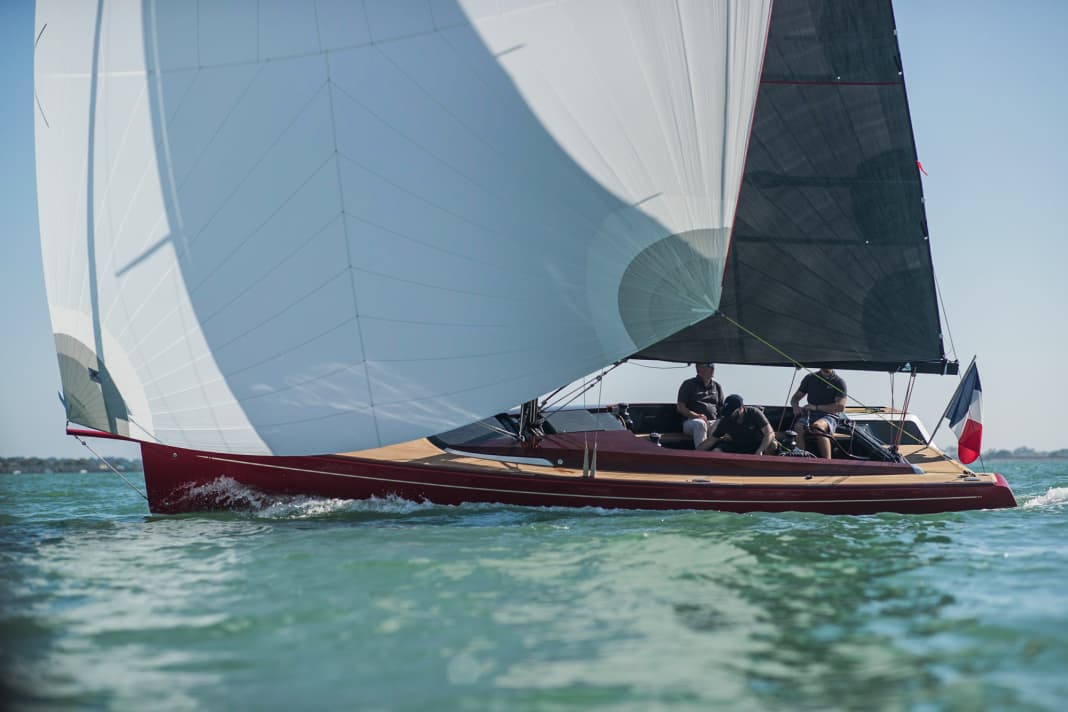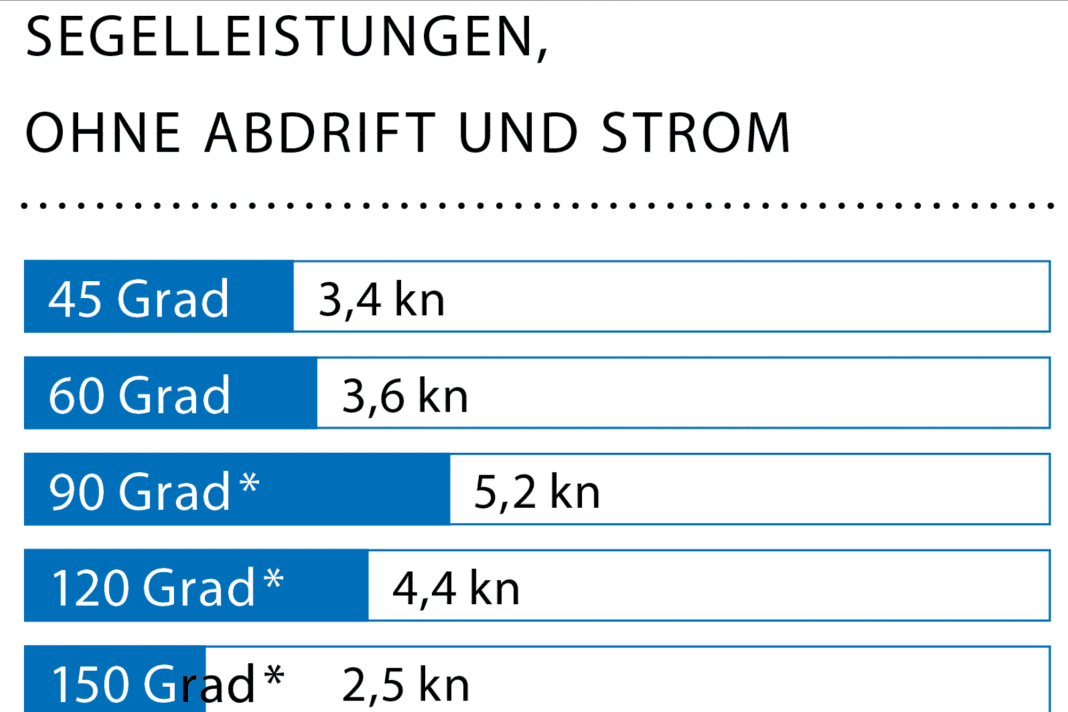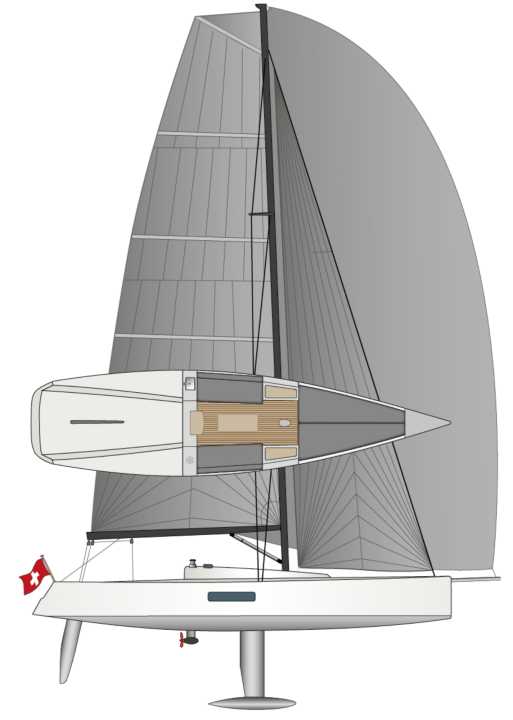Esse 330 in the test: Weekender harmonises powerful performance and comfort
Michael Good
· 17.02.2024






The Swiss is confident. "There will definitely still be a bit of wind," says Josef Schuchter, despite all the weather forecasts. They are predicting glorious autumn weather for the test on Lake Zurich - which means no hint of wind. And so it should be, at least for the time being. With the water as smooth as glass, the decision is made to set sail, even if it is initially only to gain a first impression. There is plenty of time for this.
Also for explanations. When Josef Schuchter came up with the idea of building a new sports boat 20 years ago, he could never have imagined the recognition he would receive with the Esse 850. In the very first year, he himself sailed to numerous regatta successes with build number 1 and sold a surprisingly large number of boats. And the award as European Yacht of the Year 2005 gave the young business an additional boost. To date, Josef Schuchter has delivered no fewer than 185 Esse 850s (tested in YACHT 4/2005) - a remarkable number for the small Swiss shipyard.
Schuchter also developed two other models together with his design partner, the Italian Umberto Felci: the smaller carbon fibre racer Esse 750 (YACHT 15/2011) and the larger Esse 990 (test in YACHT 21/2009), whose concept was intended to be seen less as a sports boat and more as an exclusive daysailer. However, the latter was slow to get off the ground on the market. For a boat with a hull length of just under ten metres, the beautiful and fast Esse 990 lacked the options for use as a weekender or for short trips. Below deck, it was uninhabitable and mostly empty with only two uncomfortable sunbathing areas to the side.
This meant that there was no real added value to be gained from the boat compared to the smaller Esse 850 that would have justified the steep launch price of 165,000 euros at the time.
Less sport, more living
Josef Schuchter seems to have learnt a lesson from this. With the Esse 330, he has presented a boat that offers more utilisation options on the basis of the 990. Essentially, the same boat now comes with a beautiful and cosy interior as a real weekender. In addition, the Swiss have completely redesigned the deck, with a much larger and longer cabin superstructure. Although the hull is still based on the moulds of the Esse 990, it now has a higher freeboard. Of course, these changes primarily result in more volume and therefore more living comfort below deck. In addition, the shipyard has given the new boat large hull windows, which have a positive effect on the appearance and emphasise the theme of cosiness on board.
The fact that the large Esse can sail well has already been proven as a 990 in the YACHT test. At that time, the wind conditions on Lake Zurich were better with 2 to 3 Beaufort. With an aspect ratio (length to width) of almost 3.9, the extremely slim boat surprised in particular with its excellent height upwind (75 degree tacking angle) and enormous potential under the huge gennaker set right up to the top.
However, these performance data cannot be transferred one-to-one to the Esse 330, because her rig is one metre shorter, with less sail area, due to the somewhat more moderate orientation, and she is heavier as a result of the interior fittings, around 300 kilograms. While the sail carrying capacity of the rather over-rigged Esse 990 was still above average at 6.7, it is 5.7 for the Esse 330, which is still considerable in comparison.
Hardly any wind, but already fun
In the meantime, however, there is also a gentle breeze on Lake Zurich for the current test, which slightly ripples the surface of the lake. It is not much, 2 to a maximum of 4 knots. Nevertheless, the Esse 330 picks up speed immediately, accelerates instantly and reaches a speed of 3.4 knots at an angle of around 45 degrees to the wind. With half the wind and with the large gennaker, the Swiss sailor even achieved her best performance of the day at 5.2 knots. Due to the difficult wind conditions, however, these figures should be interpreted with caution.
It can be said that the Esse 330 lies perfectly on the rudder and can be steered with a great deal of feeling on the tiller, which is a real pleasure. And her responsiveness in manoeuvres is remarkable.
Two people can handle the boat perfectly, no more crew is needed. Thanks to the standard self-tacking jib, the boat can also be handled alone without any restrictions. The guides for the sheets and trim lines are perfectly organised and all functions are easy to reach, even from the helmsman's position. A high-quality selection of deck fittings from Harken and Antal also ensures smooth trimming and manoeuvring. Due to the square head mainsail, the Esse 330 has to manage without a backstay. However, the efficient traveller on the aft deck and the powerful boom vang can largely compensate for this function.
The beautifully built carbon fibre rig from Pauger in Hungary also appears to be very stiff. The strong mast profile stands on deck and is braced with rod shrouds. All of this is part of the standard scope of delivery of the Esse 330, as is the carbon fibre boom. On the Esse 990, a larger, short overlapping genoa could be ordered as an alternative to the self-tacking jib. This option is no longer offered by the shipyard for the new boat; the self-tacking jib remains.
High forces, strong structures
The hull and deck are built at Proteus Yachts in Italy, near Verona. The structures are created as GRP sandwich constructions using a vacuum infusion process with epoxy resin. A robust carbon fibre strongback is also laminated into the boat, which absorbs the forces from the rig and keel. Because the mast is driven without a backstay, the shrouds have to be tensioned considerably more than on the 990 in order to control the sag in the forestay. The design takes this into account with the additional hull stiffeners.
The Kasko is sent to Josef Schuchter's shipyard in Stäfa on Lake Zurich for completion in accordance with the order. Here, the fittings are installed, teak is laid on request and the interior is completed. The keel and rudder are also manufactured in-house at Esseboats, not only for the 330, but also for the 850 and 750 models. For the keel, a duplex stainless steel construction is centred as a load-bearing core with a bolted lead bomb in a CNC-milled aluminium mould and completely encapsulated in synthetic resin. The process is complex, but guarantees a perfect surface and an absolutely harmonious profile. The keel is mounted in a keel box and is height-adjustable. For transport on the trailer (maximum width 2.55 metres), the ballast fin is raised by around 30 centimetres. An electro-hydraulic lifting system is available as an option.
The interior is friendly, bright and very inviting. Esseboats uses a lot of wood inside, with customers able to choose between different looks and types. The foredeck remains open and the generously sized berth area offers plenty of space for two adults to spend the night. You can also sleep comfortably on the sofas in the saloon if you remove the back cushions. Of course, there is no headroom below deck, but four people can sit very comfortably and upright on the benches; the cover of the keel box serves as a small table.
The competition: sporty weekenders for active sailors



Lots of money, lots of boat
If you want to go touring with the Esse 330, you can have a portable toilet installed in a recess provided for this purpose under the foredeck. A cool box and a small galley unit with sink are also available as extras.
Josef Schuchter himself is not satisfied with the quality of the fit-out below deck. The Italian supplier still has to work on the unsightly ceiling panelling on the prototype and the correct installation of the furniture foundations. However, the problems have been addressed and improvements have been promised for the next construction numbers.
At just under €219,000 gross, the Esse 330 is slightly cheaper than its sister model, the 990, but remains quite a bit more expensive in relation to the competition of a comparable size (e.g. from Saffier or Tofinou). In addition, this price does not include the sails or the built-in engine. The boat can be fitted with either an electric pod motor or a small diesel with saildrive.
After cost adjustment for the ready-to-sail equipment, the boat costs almost 270,000 euros, which is a lot of money for a weekender of this length and orientation. The good and elaborate construction as well as the above-average quality equipment with standard carbon fibre rig can only partially justify Esse's self-confident pricing policy.
But: Josef Schuchter has once again put together an exciting and harmonious package in which many things fit together perfectly. Anyone interested in a beautiful, exclusive daysailer or weekender will not be able to ignore the Esse 330 - regardless of what the price tag says.
The measured values for testing the Esse 330




The Esse 330 in detail

Technical data of the Esse 330
- Design engineer: Felci Yacht Design
- CE design category: C
- Torso length: 9,90 m
- Width: 2,55 m
- Draught (lifting keel): 1,60-1,90 m
- Weight: 2,45 t
- Ballast/proportion: 990 kg/47 %
- Mainsail: 40,0 m2
- Self-tacking jib: 20,0 m2
- machine (option): Electric/diesel
Hull and deck construction
GRP sandwich with foam core, built using the vacuum infusion process with epoxy resin. Carbon fibre structural frame
Price and shipyard
- Price ready to sail: 268,226 € incl. 19 % VAT.
- included in the price: Carbon rig, fittings, sheets, 12V circuit incl. battery for lighting, interior fittings incl. cushions, Torqeedo pod motor incl. battery (5,000 Wh), sail set (main, jib, gennaker)
- Guarantee/against osmosis: 1/5 year
Shipyard and distribution
Esseboats, Schuchter Sportboot AG, 8712 Stäfa, Switzerland; www.esseboats.ch
YACHT review of the Esse 330
Attractive and powerful weekender from Switzerland with a cosy interior for up to four people. The equipment with carbon fibre rig is of high quality, but the boat is also quite expensive in comparison
Design and concept
- + Coherent weekender concept
- + Simple handling
- - Many things only available as an extra
Sailing performance and trim
- + High performance potential
- + Responsive even in light winds
- + Efficient deck layout
Living and finishing quality
- + Comfortable bunks for four
- - Still some imperfections in the prototype
Equipment and technology
- + Best equipment on deck
- + Superior lightweight construction
- - No machine as standard
This article first appeared in YACHT 25-26/2019 and has been updated for this online version.

